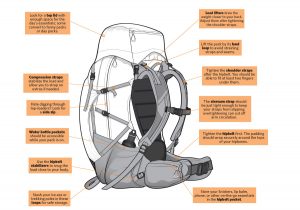How to pack before hitting the trails
Whether you’re a novice or seasoned hiker, we’ve all spent the morning of a hike quickly throwing things in our bag before rushing out the door. Understanding what to pack and how best to pack is a skill that is continually sharpened, based on where you’re headed and for how long. On top of that, companies are constantly coming out with newer gear to make it more efficient and effective. To help smooth your first hike of the season, we’ve laid out our packing tips for hikers to make sure you have everything when and where you need.

Get The Right Bag
The first step in the packing process is having the right bag for your needs. A day hike will require something much different than a backpacking trip. A good rule of thumb for the average day hiker is a bag between 18-24 liters.
Know What To Bring
The next piece of the puzzle is knowing what to bring. Without planning in advance, it’s easy to bring too much of one thing and too little of another. The easiest way to think about what to bring is to stick to the Ten Essentials. Here’s a great resource from National Park Service to break each category down for you. When it comes to food, we’ve laid out some great options for snacking in this blog to get you started.

Know Where To Pack It
It may seem like the planning stops here, but understanding where to pack your items is absolutely key. Place the heaviest items closest to your spine and near the middle of your back for the most support. Placing them further out or off center can throw off your balance and strain your muscles. Keep items you need handy in external pockets. Examples include sunscreen, maps, lip balms, head lamps, or sunglasses. Compress items, like clothing, to allow for maximum space possible. For a full breakdown, check out the above graphic by Peter Sucheski.
Practice Run
The final step to preparing and packing for a hike is to actually go through a practice run. While it may seem unnecessary, doing so will confirm you have all of the items necessary and that they’re packed effectively. Begin by laying out all of your items to take visual inventory of everything you’re putting into the bag. Practice packing and trying on your bag and tightening straps to test comfort and ensure things are sitting correctly. If there’s extra room in your bag after packing – that’s okay! Don’t add more items just because there is space available.
Explore our full tour calendar to choose a hiking or cycling trip that is right for you and your group!






